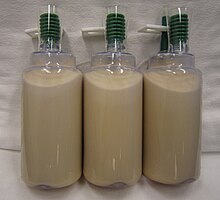
Back تسرب الكيلوس Arabic Quilotòrax Catalan Chylothorax German Quilotórax Spanish شیلوتوراکس Persian Chylothorax French Խիլոթորաքս Armenian Kilotoraks ID Chilotorace Italian 乳び胸 Japanese
| Chylothorax | |
|---|---|
 | |
| Three bottles of chyle drained from a chylothorax | |
| Specialty | Respiratory medicine |
| Symptoms | None, breathlessness |
| Complications | Dehydration, malnutrition, abnormal electrolyte levels, weakened immune system |
| Types | Low output, high output |
| Causes | Complication of surgery, trauma, cancer, infections, lymph vessel abnormalities |
| Diagnostic method | X-ray, CT scan, thoracic MRI, fluid sampling |
| Treatment | Removing fat from the diet, decreasing lymph flow, chest tube, surgery |
| Medication | Octreotide, midodrine, and sirolimus |
| Prognosis | ~10% risk of death |
A chylothorax is an abnormal accumulation of chyle, a type of lipid-rich lymph, in the pleural space surrounding the lung. The lymphatic vessels of the digestive system normally return lipids absorbed from the small bowel via the thoracic duct, which ascends behind the esophagus to drain into the left brachiocephalic vein. If normal thoracic duct drainage is disrupted, either due to obstruction or rupture, chyle can leak and accumulate within the negative-pressured pleural space. In people on a normal diet, this fluid collection can sometimes be identified by its turbid, milky white appearance, since chyle contains emulsified triglycerides.
Chylothorax is a rare but serious condition, as it signals leakage of the thoracic duct or one of its tributaries. There are many treatments, both surgical and conservative.[1] About 2–3% of all fluid collections surrounding the lungs (pleural effusions) are chylothoraces.[2] It is important to distinguish a chylothorax from a pseudochylothorax (a pleural effusion that happens to be high in cholesterol), which has a similar appearance visually but is caused by more chronic inflammatory processes and requires a different treatment.[3]
- ^ Cite error: The named reference
Mohan_2018was invoked but never defined (see the help page). - ^ "Chylothorax and Cholesterol Effusion". Pulmonology Advisor. 2019-01-23. Archived from the original on 2021-02-24. Retrieved 2019-03-24.
- ^ Heffner J. "Clinical presentation, diagnosis and management of cholesterol effusions". 8.0. UpToDate. Retrieved 30 October 2014.